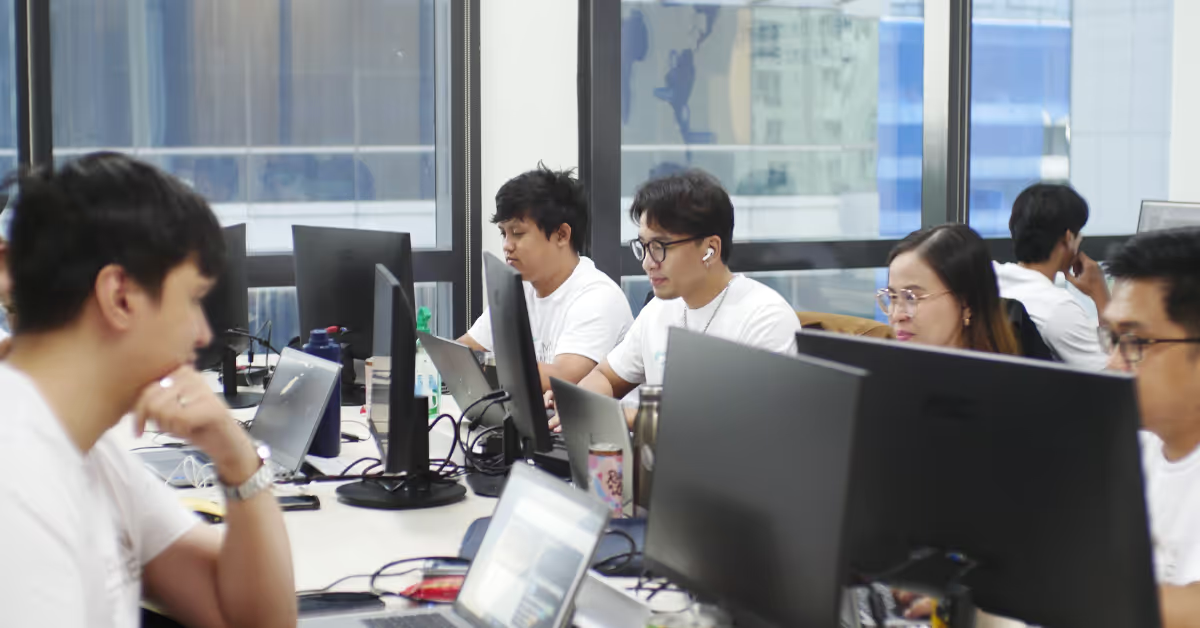How to Avoid Costly Mistakes When Hiring a Remote Developer

📌 TL;DR
Hiring the wrong remote developer is expensive; lost time, missed deadlines, and poor cultural fit can derail even the best-planned projects. The right hire, however, extends your in-house team with new skills, strengthens delivery, and helps you meet business goals faster. This guide explains what to look for in remote developers, common mistakes to avoid, and how Cloud Employee enables CTOs to build cost effective, high-performing offshore and nearshore teams for both short-term and long term projects.
The Real Challenge in Remote Hiring
For CTOs, the pressure is clear: demand for skilled software engineers is rising, yet talent remains scarce. A recent global report found that 87% of tech leaders struggle to hire qualified candidates, while unemployment among software developers is just 2.2%, underscoring how tight the labor market truly is.
When leaders look to hire offshore or nearshore developers, the challenge isn’t just technical, it’s knowing how to find people who can communicate and collaborate, integrate into your company culture, and thrive in a remote working environment.
The right hire helps your in-house team stay motivated, speeds up delivery, and ensures your projects move in line with your business goals. The wrong hire, however, increases churn, slows development, and creates hidden costs.
What a Remote Developer Really Brings to Your Team
Hiring a remote developer isn’t just about filling a technical gap, it’s about extending your team with skills, perspectives, and working styles that strengthen delivery. Through a staff augmentation model, you don’t hand off control to a third-party software development company. Instead, you integrate new talent directly into your workflows while keeping ownership of delivery.
Remote developers bring more than just code:
- Access to scarce skills: Whether AI, mobile apps, or front end development, remote hiring opens access to talent that may be difficult (or impossible) to source locally.
- Asynchronous collaboration: Experienced remote developers know how to thrive in distributed teams, working effectively across time zones while keeping momentum steady.
- Fresh perspectives: Developers from different markets bring alternative approaches to problem-solving, helping improve user experience and strengthen product quality.
- Broader project experience: Many have worked across diverse industries and projects, giving them insights your house team can learn from.
- Flexible scalability: One of the largest advantages is the ability to adjust team size in line with project needs. Instead of being locked into long-term commitments, you gain a plug-and-play model with monthly rolling contracts. This approach de-risks scaling, giving you the agility to ramp up when opportunities arise and scale back when priorities shift, all while keeping delivery smooth and cost-efficient.
- Seamless integration: They adopt your tools, align with your company culture, and work as part of your team, while being supported and employed on the back-end by Cloud Employee.
This model keeps your house team in charge while giving you flexible access to the right skill set for web platforms, mobile apps, or long term software development projects.
Why This Decision Matters Now
- Access to broader talent pools: Local markets in the US and UK are oversaturated, with demand for skilled engineers far exceeding supply. By hiring remotely (using a USA example for the purposes of this article) whether through offshoring to the Philippines or nearshoring to LATAM, you gain access to global talent pools with skills that are often unavailable or too costly to source locally. This access makes it easier to fill critical gaps quickly and build teams with the right expertise.
- Cost efficiency: In the US, hiring a contractor costs around $26,880/month. Through Cloud Employee, you can hire a skilled developer from the Philippines for $4,500/month, fully supported, saving up to 75% while still securing top-class engineers.
- Speed of hiring process: Traditional recruiting cycles often take 6–9 months, leaving projects stalled. Cloud Employee delivers pre-vetted developers in as little as one week, buying you critical time in a competitive marketplace.
- Efficiency through asynchronous work: Remote developers experienced in asynchronous collaboration can keep projects moving 24/7 across time zones. This means faster progress, fewer bottlenecks, and the ability to deliver at speed without burning out your house team.
- Flexibility for changing priorities: Whether you need to scale quickly for high level delivery or sustain capacity for long term projects, flexible remote hiring keeps costs predictable and ensures teams stay aligned with business goals.
Key Skills to Look for When Hiring a Remote Developer
Hiring remote developers isn’t the same as hiring in-house. Beyond technical ability, you need people who can operate in distributed environments, maintain momentum without daily supervision, and integrate seamlessly into your company culture. Here are the skills that matter most:
1. Technical Skill Set and Years of Experience
Every hire starts with core technical expertise. Developers should bring proven experience in your tech stack, whether for mobile apps, AI development, or complex back-end systems. But in a remote setting, experience carries more weight than in-office roles. A developer with several years of experience is more likely to handle challenges independently, adapt to long term projects, and contribute to a reliable delivery pipeline.
Without face-to-face collaboration, remote teams rely on developers who can problem-solve at a high level without constant oversight.
2. Ability to Communicate and Collaborate
Remote teams succeed or fail on communication. A developer may write brilliant code, but if they can’t document decisions, communicate blockers, or explain technical issues to your in-house team, projects stall. At Cloud Employee, every candidate goes through a CTO-led vetting process that includes pair programming, communication assessments, and problem-solving evaluations.
This ensures we only hire proactive, A-player developers who can integrate seamlessly with your workflows. With strong written and verbal communication and proven experience in asynchronous collaboration, our developers deliver clear, proactive updates that keep projects aligned with business goals and ensure user experience remains a top priority.
3. Independence and Reliability
Remote work demands self-starters. The best developers don’t wait for direction, they anticipate issues, flag risks early, and deliver consistently. The strongest hires also ladder up to wider business thinking, considering the broader context when developing.
This ability to take ownership and align technical work with business goals is especially critical when managing Agile teams spread across time zones. Without reliability and this level of contextual awareness, even the best technical skill set falls short. CTOs need developers who can sustain momentum across long term projects.
4. Cultural Fit and Team Integration
When you hire offshore development teams or build a dedicated development team, cultural alignment is just as important as technical skills. Developers must adapt to your company culture, values, and preferred working environment. For some businesses, this may also mean ensuring overlap in time zones for better collaboration.
Cultural fit reduces friction, boosts team morale, and ensures that your remote developers feel like part of your house team, not an external resource.
5. Business Awareness
The most valuable remote developers understand the “why” behind the project, not just the “what.” They connect their technical work to business goals, product strategy, and user experience.
Developers with business awareness help CTOs avoid wasted effort. Every line of code contributes to achieving long-term outcomes, not just short-term delivery.
Mistakes to Avoid
While many companies succeed with remote developers, others fall into predictable traps. Here’s what to avoid if you want your hiring process to be successful:
1. Hiring Only for Cost Savings
Cost efficiency is a major benefit of offshore and nearshore hiring, but chasing the cheapest option often leads to high turnover, poor productivity, and hidden costs in rework.
2. Skipping a Rigorous Hiring Process
Many firms rely on paper-based CV screening or unverified vendors. Without thorough testing like live coding, pair programming, or problem-solving assessments, you risk hiring a developer who can’t deliver at the level your project requires.
3. Not Hiring For Culture Fit
One of the most common mistakes is hiring purely on technical skills. If a developer can’t communicate blockers, provide clear updates, or collaborate effectively with a distributed team, your delivery speed suffers.
4. Treating Onboarding as Optional
Remote developers need structured onboarding. Skipping this step leaves them disconnected from your company culture, tools, and workflows, undermining productivity from day one.
5. Overloading Developers with Low-Level Work
Remote hires are often seen as “extra hands” rather than as extensions of your in-house team. Overloading them with repetitive low-level tasks undermines motivation and increases churn. Instead, align their role with business goals and long term projects.
Seb Hall, CEO and Founder of Cloud Employee, explains:
After more than a decade building remote-first developer teams, the biggest mistake I see is leaders treating hiring as a tick-box exercise. A wrong hire isn’t just a bad fit—it drains focus, delays delivery, and damages culture. But when you get it right, the impact is transformative: you don’t just buy skills, you buy time, momentum, and confidence in your roadmap.
Cloud Employee’s Proven Approach
Cloud Employee ensures you hire software developers who strengthen your team:
- Rigorous vetting: CTO-led vetting process ensures every developer is assessed, with live pair programming and real project scenarios.
- High retention: Over 97% of our developers stay for more than 2 years.
- Flexible scaling: Start with one engineer, expand to a dedicated development team as needed. We offer monthly rolling contracts, no placement fees, no costs unless you hire, and it’s free to interview. We provide a free replacement if your hire doesn’t work out.
- Transparent model: No hidden fees, rolling monthly contracts, full visibility of your team.
Learn more about how it works.
Case Studies
- Willo: 10 developers hired in the Philippines without visiting. 825 estimated hours saved in recruitment.
- Travel Tech Client: 35 person team hired, onboarded & managed in a few months. Dedicated UK-Based Client Services Manager.
- Salmon Software: 11 developers hired & onboarded in 6 weeks. Fully augmented team to meet internal product demands, fast.
Best Practices for CTOs and CIOs
- Define core skill sets before starting the hiring process.
- Ask candidates how they’ve worked in remote teams and contributed to asynchronous communication.
- Start small, then expand into a dedicated development team for long term projects.
- Use staff augmentation to mitigate risk, and gain access to top-tier, pre-vetted talent at a fraction of the local cost.
Hiring a remote developer is no longer just about filling a gap—it’s about finding the right skills, cultural alignment, and communication ability to extend your house team effectively. With Cloud Employee, you can build cost effective remote teams, whether offshore or nearshore, while staying in control of delivery and company culture.
👉 Ready to hire dedicated developers who fit your team and goals? Talk to Cloud Employee today.
FAQs
In the US, a contractor costs about $26,880/month. Through Cloud Employee, you can hire a skilled app developer from the Philippines for $4,500/month, saving up to 75%.
A dedicated team gives you reliable, long-term capacity that integrates with your workflows and aligns with your business goals.
Offshore development means hiring from regions like the Philippines. Nearshore means hiring from closer markets, such as LATAM for US businesses, to improve overlap with your working hours.
It gives you fast access to specialized skills while keeping control of your workflows, tools, and delivery process.






.avif)